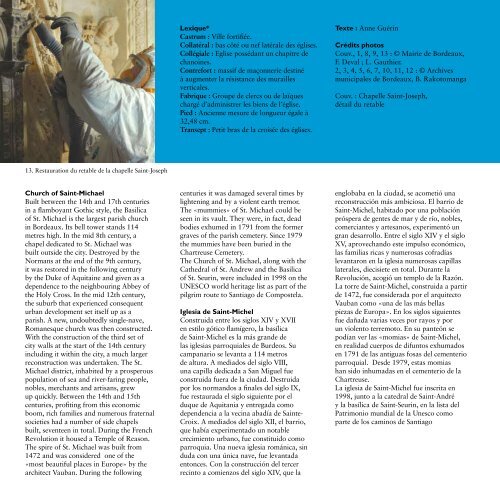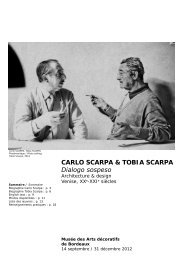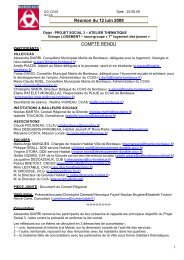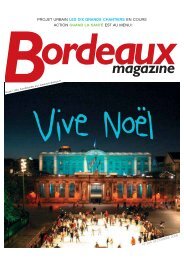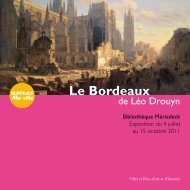L'église Saint-Michel - Bordeaux
L'église Saint-Michel - Bordeaux
L'église Saint-Michel - Bordeaux
You also want an ePaper? Increase the reach of your titles
YUMPU automatically turns print PDFs into web optimized ePapers that Google loves.
13. Restauration du retable de la chapelle <strong>Saint</strong>-Joseph<br />
Church of <strong>Saint</strong>-Michael<br />
Built between the 14th and 17th centuries<br />
in a flamboyant Gothic style, the Basilica<br />
of St. Michael is the largest parish church<br />
in <strong>Bordeaux</strong>. Its bell tower stands 114<br />
metres high. In the mid 8th century, a<br />
chapel dedicated to St. Michael was<br />
built outside the city. Destroyed by the<br />
Normans at the end of the 9th century,<br />
it was restored in the following century<br />
by the Duke of Aquitaine and given as a<br />
dependence to the neighbouring Abbey of<br />
the Holy Cross. In the mid 12th century,<br />
the suburb that experienced consequent<br />
urban development set itself up as a<br />
parish. A new, undoubtedly single-nave,<br />
Romanesque church was then constructed.<br />
With the construction of the third set of<br />
city walls at the start of the 14th century<br />
including it within the city, a much larger<br />
reconstruction was undertaken. The St.<br />
Michael district, inhabited by a prosperous<br />
population of sea and river-faring people,<br />
nobles, merchants and artisans, grew<br />
up quickly. Between the 14th and 15th<br />
centuries, profiting from this economic<br />
boom, rich families and numerous fraternal<br />
societies had a number of side chapels<br />
built, seventeen in total. During the French<br />
Revolution it housed a Temple of Reason.<br />
The spire of St. Michael was built from<br />
1472 and was considered one of the<br />
«most beautiful places in Europe» by the<br />
architect Vauban. During the following<br />
Lexique*<br />
Castrum : Ville fortifiée.<br />
Collatéral : bas côté ou nef latérale des églises.<br />
Collégiale : Eglise possédant un chapitre de<br />
chanoines.<br />
Contrefort : massif de maçonnerie destiné<br />
à augmenter la résistance des murailles<br />
verticales.<br />
Fabrique : Groupe de clercs ou de laïques<br />
chargé d’administrer les biens de l’église.<br />
Pied : Ancienne mesure de longueur égale à<br />
32,48 cm.<br />
Transept : Petit bras de la croisée des églises.<br />
centuries it was damaged several times by<br />
lightening and by a violent earth tremor.<br />
The «mummies» of St. Michael could be<br />
seen in its vault. They were, in fact, dead<br />
bodies exhumed in 1791 from the former<br />
graves of the parish cemetery. Since 1979<br />
the mummies have been buried in the<br />
Chartreuse Cemetery.<br />
The Church of St. Michael, along with the<br />
Cathedral of St. Andrew and the Basilica<br />
of St. Seurin, were included in 1998 on the<br />
UNESCO world heritage list as part of the<br />
pilgrim route to Santiago de Compostela.<br />
Iglesia de <strong>Saint</strong>-<strong>Michel</strong><br />
Construida entre los siglos XIV y XVII<br />
en estilo gótico flamígero, la basílica<br />
de <strong>Saint</strong>-<strong>Michel</strong> es la más grande de<br />
las iglesias parroquiales de Burdeos. Su<br />
campanario se levanta a 114 metros<br />
de altura. A mediados del siglo VIII,<br />
una capilla dedicada a San Miguel fue<br />
construida fuera de la ciudad. Destruida<br />
por los normandos a finales del siglo IX,<br />
fue restaurada el siglo siguiente por el<br />
duque de Aquitania y entregada como<br />
dependencia a la vecina abadía de <strong>Saint</strong>e-<br />
Croix. A mediados del siglo XII, el barrio,<br />
que había experimentado un notable<br />
crecimiento urbano, fue constituido como<br />
parroquia. Una nueva iglesia románica, sin<br />
duda con una única nave, fue levantada<br />
entonces. Con la construcción del tercer<br />
recinto a comienzos del siglo XIV, que la<br />
Texte : Anne Guérin<br />
Crédits photos<br />
Couv., 1, 8, 9, 13 : © Mairie de <strong>Bordeaux</strong>,<br />
F. Deval ; L. Gauthier.<br />
2, 3, 4, 5, 6, 7, 10, 11, 12 : © Archives<br />
municipales de <strong>Bordeaux</strong>, B. Rakotomanga<br />
Couv. : Chapelle <strong>Saint</strong>-Joseph,<br />
détail du retable<br />
englobaba en la ciudad, se acometió una<br />
reconstrucción más ambiciosa. El barrio de<br />
<strong>Saint</strong>-<strong>Michel</strong>, habitado por una población<br />
próspera de gentes de mar y de río, nobles,<br />
comerciantes y artesanos, experimentó un<br />
gran desarrollo. Entre el siglo XIV y el siglo<br />
XV, aprovechando este impulso económico,<br />
las familias ricas y numerosas cofradías<br />
levantaron en la iglesia numerosas capillas<br />
laterales, diecisiete en total. Durante la<br />
Revolución, acogió un templo de la Razón.<br />
La torre de <strong>Saint</strong>-<strong>Michel</strong>, construida a partir<br />
de 1472, fue considerada por el arquitecto<br />
Vauban como «una de las más bellas<br />
piezas de Europa». En los siglos siguientes<br />
fue dañada varias veces por rayos y por<br />
un violento terremoto. En su panteón se<br />
podían ver las «momias» de <strong>Saint</strong>-<strong>Michel</strong>,<br />
en realidad cuerpos de difuntos exhumados<br />
en 1791 de las antiguas fosas del cementerio<br />
parroquial. Desde 1979, estas momias<br />
han sido inhumadas en el cementerio de la<br />
Chartreuse.<br />
La iglesia de <strong>Saint</strong>-<strong>Michel</strong> fue inscrita en<br />
1998, junto a la catedral de <strong>Saint</strong>-André<br />
y la basílica de <strong>Saint</strong>-Seurin, en la lista del<br />
Patrimonio mundial de la Unesco como<br />
parte de los caminos de Santiago


